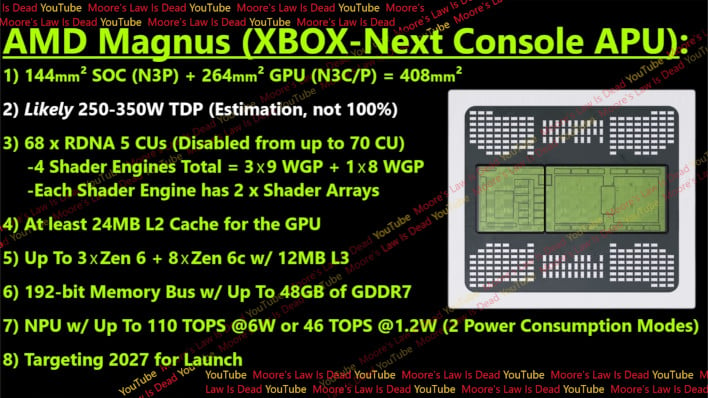Next-Gen Xbox Rumored For AMD Magnus Chiplet Packing 48GB GDDR7 For Gaming
Of course, a lot of things can change between now and the mooted 2027 release, and rumors should always be taken with some degree of salt. This applies especially when the source of information is YouTuber Moore's Law is Dead, but while his track record isn't perfect, when he's right, he's bang-on. With that disclaimer in mind, let's start digging into the meat of these rumors and paint them in context of what else we know about the coming generation of AMD-powered PlayStation and Xbox consoles.
Projected Xbox Magnus Specifications & What They Mean

If these specifications prove true, the next Xbox console may prove more expensive than even the current PS5 Pro. Pricing estimates start at around $1000, which is already the price point of the handheld Asus ROG Xbox Ally X. MLID posits that while this would be quite expensive for a console, it should give Xbox a meaningful performance lead over the PlayStation 6, and if Windows support is included, even make it competitive with lots of pre-built PCs in the price range.
With all that said, there are still some details that make these specifications seem less likely—especially that astronomical 48 GB of GDDR7 RAM. The entire RDNA 5 architecture looks to be one of the most efficient solutions for ray tracing yet seen, with stated goals of alleviating CPU bottlenecks and GPU memory bandwidth demands enough to make path traced graphics possible on PlayStation 6. Graphics memory isn't getting cheaper any time soon, so the idea of 48 GB of GDDR7 getting packed into a console seems... unlikely, even at a ~$1000 price point. The leaker points to statements from developers that this large memory will be necessary to enable the use of large AI models, such as LLMs, in games.
We'd be happy to be proven wrong. The idea of Xbox providing an actually-competitive piece of hardware, especially one that puts pressure on overpriced prebuilt PCs with Windows support, is quite nice, but until more substantial evidence of these claims materialize, this is starting to sound like a pipe dream ignoring Xbox's very obvious last place in the console race for the past two generations.
Top image: Microsoft, Middle image: Moore's Law is Dead


